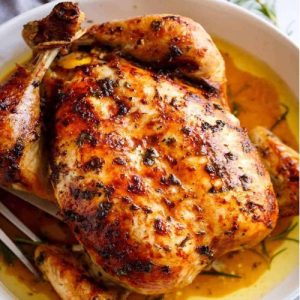
Garlic Butter Crispy Roast Chicken
A juicy, garlic butter roasted chicken infused with fresh herbs, lemon, and white wine, finished with irresistibly crispy skin. A comforting yet healthy dish that’s rich in protein, low in carbs, and perfect for weeknight dinners or family gatherings.
Equipment
- 1 roasting pan or baking tray
- Foil (optional, for lining)
- 1 kitchen string (for tying legs)
- 1 small mixing bowl
- Paper towels (for patting dry)
- Basting brush or spoon
Ingredients
- 1 whole chicken 4 lbs / ~1.8 kg, room temperature, giblets & neck removed
- ¼ cup unsalted butter melted
- 3 tablespoons olive oil
- ¼ cup dry white wine optional, e.g., Sauvignon Blanc or Chardonnay
- 1 lemon halved
- Salt to taste
- Black pepper to taste
- 2 tablespoons fresh parsley chopped
- 4 cloves garlic minced
- 1 head garlic cut in half crosswise
- 3 sprigs fresh rosemary
Instructions
- Prepare the Oven and Pan: Preheat your oven to 430°F (220°C), or 400°F (200°C) if using a fan-forced setting. While the oven heats, line a roasting tray or large baking dish with foil for easy cleanup, or lightly grease it with oil to prevent sticking. A sturdy pan with sides works best to catch flavorful juices that can later be spooned over the chicken.
- Clean and Dry the Chicken: Remove the chicken from the refrigerator and allow it to come closer to room temperature—this ensures even cooking. Discard the neck, giblets, and any excess fat from the cavity if not already removed. Using paper towels, thoroughly pat the chicken dry, inside and out. Dry skin is key to achieving that golden, crisp exterior.
- Mix the Flavor Base: In a small bowl, combine the melted butter, olive oil, and white wine (if using). Squeeze the juice from half of the lemon into the mixture and whisk lightly until blended. This creates a fragrant, buttery baste that will flavor the meat from both the outside and inside.
- Season Generously: Rub the butter mixture all over the chicken—across the skin, under the skin (especially over the breast for added juiciness), and inside the cavity. Use your hands or a basting brush to get into every corner. Sprinkle salt, black pepper, and chopped parsley generously over the chicken, ensuring even coverage. A well-seasoned bird is the foundation of rich flavor.
- Infuse with Garlic and Herbs: Massage the minced garlic directly into the skin, pressing it gently so it adheres. For deep flavor infusion, place the halved garlic head, fresh rosemary sprigs, and the squeezed lemon half inside the cavity of the chicken. These aromatics will release their fragrance as the chicken roasts, perfuming the meat from within.
- Tie and Position the Chicken: Using kitchen string, tie the chicken legs together to keep the stuffing inside and promote even cooking. Tuck the wing tips underneath the body to prevent burning. Place the chicken breast-side up in the prepared roasting pan. This position ensures the breast stays tender while the skin crisps beautifully.
- Roast to Juicy Perfection: Transfer the pan to the preheated oven and roast for 1 hour and 15–20 minutes. Halfway through cooking, carefully remove the pan and baste the chicken with its own juices using a spoon or baster. This keeps the meat moist and the skin richly flavored. Return it to the oven and continue roasting until the skin is golden and the meat is nearly done.
- Check for Doneness: The chicken is fully cooked when the juices run clear after piercing the thickest part of the thigh with a skewer. For accuracy, insert a meat thermometer into the thigh without touching the bone—it should read at least 165°F (75°C). If the skin isn’t quite crisp enough, broil the chicken for an additional 2–3 minutes until it turns deep golden brown.
- Rest Before Serving: Remove the chicken from the oven and tent it loosely with foil. Let it rest for 10 minutes before carving.Resting allows the juices to redistribute throughout the meat, ensuring every slice is tender and succulent rather than dry.
- Serve and Enjoy: Transfer the roasted chicken to a serving platter. Spoon the pan juices over the meat for added flavor, and serve alongside the remaining half lemon, cut into wedges or slices, for a fresh citrusy kick. Pair with roasted vegetables, mashed potatoes, or a crisp salad for a complete, balanced meal.
Notes
- For best results, bring the chicken to room temperature before roasting—it ensures even cooking.
- Always pat the skin dry before seasoning to achieve extra-crispy skin.
- White wine adds depth of flavor, but you can substitute with chicken broth or skip it entirely.
- Fresh herbs like rosemary and parsley add fragrance, but thyme or sage can be used too.
- Don’t skip resting time; it keeps the chicken juicy and prevents it from drying out.
- Broiling for the last 2–3 minutes guarantees a golden-brown finish.
- Save the pan juices—they make a quick, flavorful gravy or drizzle.
- Use a meat thermometer to avoid undercooked or overcooked chicken.
- Tie the legs and tuck the wings to promote even cooking and prevent burning.
- Leftovers taste great in sandwiches, wraps, or salads.